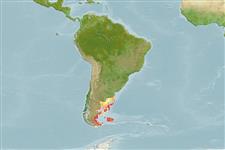Classification / Names
Common names from other countries
Main reference
Size / Weight / Age
Max length : 18.0 cm SL male/unsexed; (Ref. 188); common length : 15.0 cm SL male/unsexed; (Ref. 188)
Environment
Marine; pelagic-neritic; oceanodromous (Ref. 51243); depth range 10 - ? m
Climate / Range
Subtropical, preferred 8°C (Ref. 107945); 38°S - 58°S, 70°W - 57°W (Ref. 188)
Distribution
Short description
Dorsal
spines
(total): 0;
Dorsal
soft rays
(total): 13-21;
Anal
spines: 0;
Anal
soft rays: 12 - 23;
Vertebrae: 52 - 58. Lower jaw slightly projecting, gill cover without bony radiating striae. Last two anal fin rays not enlarged. No dark spots on flanks. Pterotic bulla absent. Body dark blue dorsally and silvery white laterally and ventrally (Ref. 27363). All fins translucent (Ref. 27363).
IUCN Red List Status (Ref. 115185)
Threat to humans
Harmless
Human uses
Fisheries: commercial
Tools
Special reports
Download XML
Internet sources
Estimates of some properties based on models
Phylogenetic diversity index
PD50 = 0.5312 many relatives (e.g. carps) 0.5 - 2.0 few relatives (e.g. lungfishes)
Trophic Level
2.6 ±0.26 se; Based on food items.
Resilience
High, minimum population doubling time less than 15 months (K=0.7)
Vulnerability
Low vulnerability (14 of 100)
Price category
